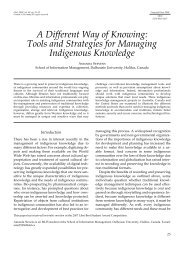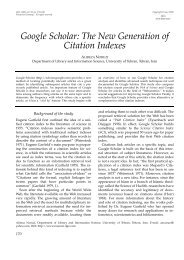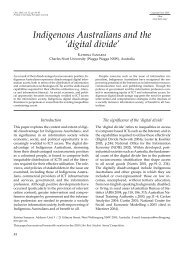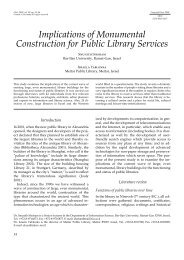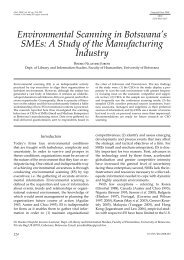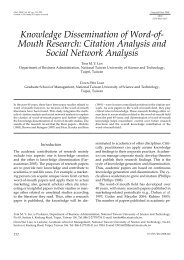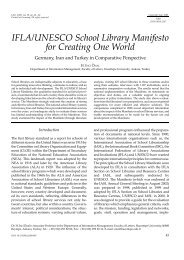A Comparison of Print and Electronic Journal Holdings in ... - Libri
A Comparison of Print and Electronic Journal Holdings in ... - Libri
A Comparison of Print and Electronic Journal Holdings in ... - Libri
Create successful ePaper yourself
Turn your PDF publications into a flip-book with our unique Google optimized e-Paper software.
<strong>Libri</strong>, 2003, vol. 53, pp. 237–241<br />
<strong>Pr<strong>in</strong>t</strong>ed <strong>in</strong> Germany · All rights reserved<br />
Copyright © Saur 2003<br />
_____________________________________________<br />
<strong>Libri</strong><br />
ISSN 0024-2667<br />
A <strong>Comparison</strong> <strong>of</strong> <strong>Pr<strong>in</strong>t</strong> <strong>and</strong><br />
<strong>Electronic</strong> <strong>Journal</strong> <strong>Hold<strong>in</strong>gs</strong><br />
<strong>in</strong> Academic <strong>and</strong> Public Libraries<br />
PETER MCCRACKEN<br />
Serials Solutions, Inc., Seattle, WA, USA<br />
The past few years have seen an enormous growth <strong>in</strong> the<br />
number <strong>of</strong> journals that libraries can access electronically.<br />
This is a well-researched <strong>and</strong> well-documented phenomenon,<br />
but no studies have compared the actual number <strong>of</strong><br />
electronic journals a library can access, particularly <strong>in</strong> comparison<br />
with the total number <strong>of</strong> journals they receive<br />
through all sources, <strong>in</strong>clud<strong>in</strong>g pr<strong>in</strong>t. The growth <strong>of</strong> serials<br />
management companies suggests the possibility <strong>of</strong> this research.<br />
Through analysis <strong>of</strong> resources tracked by Serials<br />
Solutions, Inc., one can get a firm grasp on how many<br />
electronic journals a library is track<strong>in</strong>g, <strong>in</strong> comparison with<br />
the number <strong>of</strong> pr<strong>in</strong>t or micr<strong>of</strong>ilm titles they have. This article<br />
presents the first comprehensive analysis <strong>of</strong> how many<br />
journals public <strong>and</strong> various types <strong>of</strong> academic libraries can<br />
access electronically, rather than <strong>in</strong> pr<strong>in</strong>t. While highlight<strong>in</strong>g<br />
the <strong>in</strong>credible <strong>in</strong>crease <strong>in</strong> access to <strong>in</strong>formation electronically,<br />
it also identifies the limitations <strong>of</strong> the current research,<br />
particularly regard<strong>in</strong>g libraries’ pr<strong>in</strong>t hold<strong>in</strong>gs. As data collection<br />
improves, future research will be more accurate, <strong>and</strong><br />
will provide a basis for study<strong>in</strong>g both the growth <strong>of</strong> electronic<br />
access to journals <strong>and</strong> the expected reduction <strong>in</strong> pr<strong>in</strong>t<br />
access to journals.<br />
Methodology<br />
Serials Solutions, Inc., was the first company to<br />
provide a comprehensive solution to determ<strong>in</strong><strong>in</strong>g<br />
which journals a library could access through its<br />
electronic databases. The company has nearly<br />
1200 separate clients, with products <strong>in</strong> use <strong>in</strong> over<br />
1600 libraries around the world. Because Serials<br />
Solutions also <strong>of</strong>fers complete MARC records for<br />
journals <strong>and</strong> an OpenURL resolver, accurate <strong>and</strong><br />
authoritative data is a critical piece <strong>of</strong> the company’s<br />
growth. While competitors have jo<strong>in</strong>ed<br />
(<strong>and</strong> left) this market, none has anywhere close to<br />
as many clients as Serials Solutions, <strong>and</strong> therefore<br />
none has the ability to study this data as accurately<br />
as Serials Solutions.<br />
The services provided by Serials Solutions require<br />
that we receive or collect lists <strong>of</strong> titles <strong>and</strong><br />
ISSNs from database aggregators <strong>and</strong> publishers,<br />
<strong>and</strong> compile them <strong>in</strong>to a s<strong>in</strong>gle, large database.<br />
This database reflects hold<strong>in</strong>gs for all journals <strong>in</strong><br />
all <strong>of</strong> the aggregated databases tracked. The manner<br />
<strong>in</strong> which the database aggregators describe<br />
their content, however, provides a challenge. Aggregators<br />
may or may not <strong>in</strong>clude an ISSN, <strong>and</strong><br />
when they do, the ISSN may be <strong>in</strong>correct. Aggregators<br />
may or may not <strong>in</strong>clude the publication<br />
location, abbreviations, subtitles, older titles, or<br />
other pieces <strong>of</strong> additional <strong>in</strong>formation. Often, the<br />
titles conta<strong>in</strong> mis<strong>in</strong>terpretations <strong>of</strong> the title or<br />
even basic misspell<strong>in</strong>gs. While the human eye<br />
can quickly see that variant title/ISSN comb<strong>in</strong>ations<br />
all <strong>in</strong>tend to refer to the same serial, the<br />
computer cannot. Table 1 provides several examples<br />
<strong>of</strong> the irregular title <strong>and</strong> ISSN comb<strong>in</strong>ations<br />
that come from different providers.<br />
The result <strong>of</strong> all <strong>of</strong> this variation is that Serials<br />
Solutions must spend a great deal <strong>of</strong> time “normaliz<strong>in</strong>g”<br />
these data to a s<strong>in</strong>gle, agreed-upon title<br />
for each journal. To do that, <strong>and</strong> <strong>in</strong> order to deliver<br />
This paper is part <strong>of</strong> the <strong>Libri</strong> Special Thread on Internet Publish<strong>in</strong>g; started <strong>in</strong> no. 3 <strong>of</strong> the current volume<br />
Peter McCracken, MLS. Co-founder, Serials Solutions, Inc., 444 NE Ravenna Blvd., Suite 211, Seattle, WA 98115 USA. Tel: +1<br />
(206) 545-9056 ext. 17, +1 (866) SERIALS ext. 17. Fax: +1 (206) 525-9066. E-mail: peter@serialssolutions.com<br />
237
Peter McCracken<br />
Table 1. Three examples <strong>of</strong> variable title/ISSN comb<strong>in</strong>ations<br />
provided by database aggregators. In the second <strong>and</strong><br />
third examples, <strong>in</strong>valid ISSNs are <strong>in</strong> italics.<br />
________________________________________________________________________________<br />
<strong>Journal</strong> : Technological Horizons <strong>in</strong> Education 0192-592X<br />
T H E <strong>Journal</strong> 0192-592X<br />
T H E <strong>Journal</strong> (Technological Horizons In<br />
Education)<br />
T H E <strong>Journal</strong> (Technological Horizons In 0192-592X<br />
Education)<br />
T.H.E. journal 0192-592X<br />
T.H.E. JOURNAL (TECH HORIZONS IN 0192-592X<br />
EDUCATION JOURNAL<br />
T.H.E. <strong>Journal</strong> (Technical Horizons <strong>in</strong> Education) 0192-592X<br />
T.H.E. <strong>Journal</strong>: Technological Horizons <strong>in</strong> 0192-592X<br />
Education<br />
T.H.E. <strong>Journal</strong>; technological horizons <strong>in</strong> 0192-592X<br />
education<br />
Technological horizons <strong>in</strong> education 0192-592X<br />
Technological horizons <strong>in</strong> education journal 0192-592X<br />
THE journal 0192-592X<br />
THE journal : technological horizons <strong>in</strong> 0192-592X<br />
education<br />
Remix<br />
Remix 1532-1327<br />
Remix 1532-1347<br />
Remix 1533-1327<br />
Remix (Emeryv. Calif.) 1532-1347<br />
Remix (Emeryville, Calif.) 1532-1347<br />
Hypatia<br />
Hypatia 0886-5367<br />
Hypatia 0887-5367<br />
Hypatia (Edwardsville, Ill.) 0887-5367<br />
Hypatia- A <strong>Journal</strong> <strong>of</strong> Fem<strong>in</strong>ist Philosophy 0887-5367<br />
Hypatia: A <strong>Journal</strong> <strong>of</strong> Fem<strong>in</strong>ist Philosophy 0887-5367<br />
Hypatia: A <strong>Journal</strong> <strong>of</strong> Fem<strong>in</strong>ist Philosophy 0887-5637<br />
Hypatia: a journal <strong>of</strong> fem<strong>in</strong>ist philosophy (Univ. 0887-5367<br />
<strong>of</strong> Oregon, Eugene)<br />
Hypatia-A<br />
________________________________________________________________________________<br />
<strong>Journal</strong> <strong>of</strong> Fem<strong>in</strong>ist Philosophy 0887-5367<br />
our MARC record product, we associate title/<br />
ISSN comb<strong>in</strong>ations with MARC records obta<strong>in</strong>ed<br />
from the Library <strong>of</strong> Congress. These records are all<br />
created to the highest exist<strong>in</strong>g catalog<strong>in</strong>g st<strong>and</strong>ards,<br />
as set by CONSER, the Cooperative Onl<strong>in</strong>e<br />
Serials Program, a component <strong>of</strong> the Program for<br />
Cooperative Catalog<strong>in</strong>g at the Library <strong>of</strong> Congress.<br />
By associat<strong>in</strong>g these title/ISSN comb<strong>in</strong>ations<br />
to exist<strong>in</strong>g, quality MARC records, we are<br />
able to accurately determ<strong>in</strong>e the number <strong>of</strong> true<br />
serials that are available to a library <strong>in</strong> an electronic<br />
format.<br />
To develop this study, the author created a cohort<br />
<strong>of</strong> libraries that are Serials Solutions clients<br />
from each <strong>of</strong> the major Carnegie classifications [1],<br />
plus a separate group <strong>of</strong> public libraries. The libraries<br />
<strong>in</strong> this study had to be Serials Solutions<br />
clients, as it is necessary to review each library’s<br />
pr<strong>of</strong>ile <strong>of</strong> subscribed databases to determ<strong>in</strong>e how<br />
many electronic journals they can access. Every<br />
fifth library <strong>in</strong> each Carnegie classification was<br />
selected, <strong>and</strong> checked to see if they were a Serials<br />
Solutions client. From the result<strong>in</strong>g set <strong>of</strong> Serials<br />
Solutions clients, sixty libraries were r<strong>and</strong>omly<br />
selected from the Associates, Baccalaureates, <strong>and</strong><br />
Masters classifications, <strong>and</strong> thirty from the Doctorals<br />
classification. Twenty-five public libraries,<br />
<strong>of</strong> all sizes, were also studied. No <strong>in</strong>dividual <strong>in</strong>formation<br />
about each library is expressed or described<br />
here; all <strong>in</strong>formation is presented <strong>in</strong> the<br />
aggregate.<br />
The author compiled <strong>in</strong>formation about the<br />
number <strong>of</strong> journals the library can access electronically,<br />
<strong>and</strong> compared that with data about the<br />
number <strong>of</strong> journals the library can access <strong>in</strong> pr<strong>in</strong>t.<br />
Two sources, the IPEDS data <strong>of</strong> 1998, [2] <strong>and</strong> the<br />
2002 American Library Directory (“ALD”), [3] provided<br />
the most current <strong>in</strong>formation available<br />
about the number <strong>of</strong> journals each library can access.<br />
Discussion about the variation <strong>in</strong> those<br />
numbers will follow.<br />
When Serials Solutions delivers A-to-Z title<br />
lists, these lists <strong>in</strong>clude multiple hold<strong>in</strong>gs for each<br />
journal. If a s<strong>in</strong>gle journal is available through<br />
five separate databases from three different aggregators,<br />
the journal will be identified five separate<br />
times. In deliver<strong>in</strong>g MARC records, however,<br />
those five separate databases are listed separately,<br />
but on just one s<strong>in</strong>gle MARC record. By count<strong>in</strong>g<br />
the number <strong>of</strong> MARC records Serials Solutions<br />
would create for a client library if they purchased<br />
our MARC record service, we can determ<strong>in</strong>e how<br />
many true journals they can access. This number<br />
can then be compared with the number <strong>of</strong> titles<br />
listed <strong>in</strong> various other sources.<br />
Many aggregators <strong>in</strong>clude non-serial items,<br />
such as transcripts, brochures, reports, supplements,<br />
corporate annual reports, etc., <strong>and</strong> these<br />
<strong>in</strong>crease the number <strong>of</strong> titles they can claim to<br />
<strong>of</strong>fer. These are not serial <strong>in</strong> nature, however, <strong>and</strong><br />
should not be counted toward the number <strong>of</strong> journals<br />
their clients can access. S<strong>in</strong>ce no CONSER<br />
MARC records will be found for these non-serial<br />
items, they will not be <strong>in</strong>cluded <strong>in</strong> the number <strong>of</strong><br />
MARC records Serials Solutions would create for<br />
these libraries. On the other h<strong>and</strong>, many local or<br />
238
A <strong>Comparison</strong> <strong>of</strong> <strong>Pr<strong>in</strong>t</strong> <strong>and</strong> <strong>Electronic</strong> <strong>Journal</strong> <strong>Hold<strong>in</strong>gs</strong> <strong>in</strong> Academic <strong>and</strong> Public Libraries<br />
regional papers, for which CONSER records do<br />
not yet exist, are <strong>in</strong>cluded <strong>in</strong> these resources. In<br />
some cases, CONSER records exist, but have not<br />
yet been located. The result is that the numbers<br />
given as the number <strong>of</strong> serial titles available at an<br />
<strong>in</strong>stitution are somewhat undercounted.<br />
After collect<strong>in</strong>g data on the number <strong>of</strong> electronic<br />
journals a library can access, the author<br />
compared that with the number <strong>of</strong> journals a library<br />
has reported it can access. Because data<br />
from the two sources for pr<strong>in</strong>t hold<strong>in</strong>gs (2002<br />
American Library Directory <strong>and</strong> 1998 IPEDS data)<br />
<strong>of</strong>ten varied dramatically, the author always<br />
selected the higher <strong>of</strong> the two numbers. It appears<br />
that most <strong>in</strong>stitutions reported only pr<strong>in</strong>t<br />
hold<strong>in</strong>gs, while some reported pr<strong>in</strong>t <strong>and</strong> electronic<br />
hold<strong>in</strong>gs. See the Additional Comments section below<br />
for further discussion <strong>of</strong> this issue. The number<br />
<strong>of</strong> journals reported through IPEDS or ALD<br />
was added to the number <strong>of</strong> electronic journals,<br />
<strong>and</strong> the number <strong>of</strong> electronic journals was divided<br />
by the number <strong>of</strong> all journals. The results<br />
were computed <strong>and</strong> averaged with each Carnegie<br />
classification <strong>and</strong> <strong>in</strong> a separate section for public<br />
libraries. Those results are presented <strong>in</strong> Table 2.<br />
Results <strong>and</strong> analysis<br />
Table 2. <strong>Comparison</strong> <strong>of</strong> e-journal <strong>and</strong> reported journal hold<strong>in</strong>gs<br />
by library type.<br />
_________________________________________________________________________________<br />
Institution type<br />
Average<br />
number <strong>of</strong><br />
reported<br />
journals [b]<br />
Average<br />
number <strong>of</strong><br />
electronic<br />
journals[c]<br />
This study compared electronic journal hold<strong>in</strong>gs<br />
versus all journal hold<strong>in</strong>gs <strong>in</strong> sixty <strong>in</strong>stitutions <strong>in</strong><br />
each <strong>of</strong> the Carnegie classifications <strong>of</strong> Associates,<br />
Baccalaureate, <strong>and</strong> Masters; thirty <strong>in</strong>stitutions<br />
<strong>in</strong> the Carnegie classification <strong>of</strong> Doctorate; <strong>and</strong><br />
twenty-five public libraries. Twelve <strong>of</strong> those libraries<br />
are among the 75 largest public libraries<br />
<strong>in</strong> the country; twenty are <strong>in</strong> the top 10% by book<br />
volume; <strong>and</strong> twenty-three <strong>of</strong> the twenty-five are<br />
<strong>in</strong> the top 20% by book volume. As a result, the<br />
number <strong>of</strong> reported journals for public libraries is<br />
significantly larger than the national average for<br />
all public libraries. For Associates <strong>in</strong>stitutions, on<br />
average, 86.5% <strong>of</strong> their periodical titles are available<br />
electronically. For Baccalaureate <strong>in</strong>stitutions,<br />
on average 83.3% <strong>of</strong> their periodical titles are<br />
available electronically. For Masters <strong>in</strong>stitutions,<br />
on average 71.3% <strong>of</strong> their titles are available electronically.<br />
For Doctoral <strong>in</strong>stitutions, on average<br />
39.5% <strong>of</strong> their titles are available electronically.<br />
For public libraries, on average 64.3% <strong>of</strong> their<br />
titles are available electronically. S<strong>in</strong>ce almost<br />
none <strong>of</strong> these <strong>in</strong>stitutions are track<strong>in</strong>g their electronic<br />
journals through their onl<strong>in</strong>e catalogs,<br />
most academic libraries <strong>in</strong> the United States are<br />
unable to access between 80% <strong>and</strong> 90% <strong>of</strong> their<br />
entire periodical collection. They may have an<br />
A-to-Z list <strong>of</strong> their electronic journals, but this requires<br />
that patrons know to search both the OPAC<br />
<strong>and</strong> the A-to-Z list when seek<strong>in</strong>g a specific title.<br />
Without effective quality control, some A-to-Z lists<br />
conta<strong>in</strong> the numerous errors that were <strong>in</strong>itially<br />
<strong>in</strong>troduced by the aggregators themselves. Libraries<br />
without A-to-Z lists have almost no knowledge<br />
<strong>of</strong> what they can access through their myriad<br />
databases.<br />
Students clearly prefer electronic access to journals,<br />
as any <strong>in</strong>dividual who has worked at a reference<br />
desk can attest. Libraries, <strong>in</strong> their attempts to<br />
fill these wants, have moved <strong>in</strong>creas<strong>in</strong>g amounts<br />
<strong>of</strong> their resources toward obta<strong>in</strong><strong>in</strong>g journals<br />
electronically, but have not kept up with track<strong>in</strong>g<br />
these journals for their patrons, or mak<strong>in</strong>g these<br />
journals fully accessible to their patrons. When<br />
purchas<strong>in</strong>g onl<strong>in</strong>e resources, librarians need to<br />
ensure that their patrons can determ<strong>in</strong>e what is<br />
conta<strong>in</strong>ed <strong>in</strong> these resources, <strong>and</strong> then access the<br />
resources <strong>in</strong> a manner with which they are<br />
familiar.<br />
Additional comments<br />
E-journals as<br />
a percent <strong>of</strong><br />
all journals<br />
_________________________________________________________________________________<br />
Associate [a]<br />
(n=60)<br />
Baccalaureate [a]<br />
(n=60)<br />
Masters [a]<br />
(n=60)<br />
Doctoral [a]<br />
(n=30)<br />
Public, large<br />
(n=25)<br />
874 5,617 86.5%<br />
1,372 6,841 83.3%<br />
3,178 7,910 71.3%<br />
15,046 9,836 39.5%<br />
3,529 6,362 64.3%<br />
_________________________________________________________________________________<br />
a. per Carnegie Classification, 2000.<br />
b. greater <strong>of</strong> 1998 IPEDS or 2002 American Library Directory (no<br />
IPEDS data available for public libraries)<br />
c. Serials Solutions data, June & September 2003<br />
One great surprise from this study was the extreme<br />
variation <strong>in</strong> data reported by libraries to<br />
the various sources used for collect<strong>in</strong>g <strong>in</strong>forma-<br />
239
Peter McCracken<br />
Figure 1. <strong>Comparison</strong> <strong>of</strong> journal counts <strong>in</strong> IPEDS 1998 <strong>and</strong><br />
ALD 2002 data.<br />
Scales on both axes are logarithmic.<br />
tion on the number <strong>of</strong> journals available <strong>in</strong> a library.<br />
The most recent IPEDS data available was<br />
from 1998; it was released <strong>in</strong> July 2002. While<br />
journal counts can certa<strong>in</strong>ly vary from year to<br />
year, <strong>and</strong> four years’ separation between data collection<br />
could lead to some variation <strong>in</strong> the number<br />
<strong>of</strong> titles available at a specific <strong>in</strong>stitution, it<br />
cannot expla<strong>in</strong> the massive variation between<br />
numbers provided by libraries for the two sources<br />
used <strong>in</strong> this study.<br />
Know<strong>in</strong>g what is or is not a journal can sometimes<br />
be tricky. Know<strong>in</strong>g which ones to report,<br />
<strong>and</strong> when, can be downright hopeless. Libraries<br />
can be excused for not be<strong>in</strong>g certa<strong>in</strong> which types<br />
<strong>of</strong> journals to report where, <strong>and</strong> some fault does<br />
lie with those creat<strong>in</strong>g data collection forms. But<br />
many libraries report very different numbers <strong>in</strong><br />
the two different sources used <strong>in</strong> this study. The<br />
general <strong>in</strong>structions for 1998 IPEDS data collection<br />
sheet for the relevant fields reads,<br />
Current serial subscriptions (l<strong>in</strong>es 30 <strong>and</strong> 31) – Report the<br />
total number <strong>of</strong> current serials received <strong>in</strong>clud<strong>in</strong>g those<br />
that are paid <strong>and</strong> those received without payment. Include<br />
government documents issued serially. Each available<br />
title counts as one when titles are received as part <strong>of</strong><br />
an electronic subscription. [4]<br />
Information Today, current publishers <strong>of</strong> the<br />
American Library Directory, does not provide a<br />
def<strong>in</strong>ition for the field <strong>in</strong> which they request <strong>in</strong>formation<br />
about periodicals: they simply request<br />
a number, <strong>and</strong> leave it to the library to decide<br />
how to def<strong>in</strong>e that number. [5]<br />
Figure 1 shows a comparison <strong>of</strong> journal numbers<br />
reported to IPEDS <strong>and</strong> to the American Library<br />
Directory. One Associates <strong>in</strong>stitution reported<br />
220 journal subscriptions to ALD, <strong>and</strong> 12,860 to<br />
IPEDS. Another reported 36 journal subscriptions<br />
to ALD, <strong>and</strong> 335 to IPEDS. Yet another reported<br />
4700 to ALD, <strong>and</strong> 500 to IPEDS. Wildly varied results<br />
appear throughout the graph <strong>in</strong> Figure 1.<br />
(Note that scales on both axes are logarithmic, to<br />
better present the data.)<br />
While it can be a challenge for an <strong>in</strong>stitution to<br />
determ<strong>in</strong>e data, <strong>and</strong> a challenge for others to collect<br />
data, little can be learned without accurate<br />
metadata. If researchers are to determ<strong>in</strong>e what<br />
works, <strong>and</strong> what does not, they must be able to<br />
access reliable data that accurately reflects comparable<br />
<strong>in</strong>formation across members <strong>of</strong> a cohort.<br />
Conclusion<br />
<strong>Electronic</strong> journals are a fact <strong>of</strong> life <strong>in</strong> today’s library.<br />
Patrons <strong>and</strong> librarians recognize their<br />
value, <strong>and</strong> access through database aggregators,<br />
while occasionally problematic, is also <strong>in</strong>credibly<br />
cost-effective. Unfortunately, however, the vast<br />
majority <strong>of</strong> most libraries’ journal hold<strong>in</strong>gs are<br />
now compiled with<strong>in</strong> these databases, <strong>and</strong> very<br />
few libraries are able to track the journals <strong>in</strong> these<br />
databases, particularly through the OPAC. If libraries<br />
are to obta<strong>in</strong> the greatest possible value<br />
from the journals <strong>in</strong> these databases, they need to<br />
present <strong>in</strong>formation about these journals to their<br />
patrons.<br />
Notes<br />
1. The Carnegie Classification System is a systematic<br />
classification <strong>of</strong> <strong>in</strong>stitutions <strong>of</strong> higher education <strong>in</strong><br />
the United States accord<strong>in</strong>g to such variables as<br />
degrees <strong>of</strong>fered, size, <strong>and</strong> commitment to research.<br />
The categories <strong>in</strong>clude: Doctorate-grant<strong>in</strong>g Institutions,<br />
Master’s Colleges <strong>and</strong> Universities, Baccalaureate<br />
Colleges, Associate’s Colleges, Specialized<br />
Institutions <strong>and</strong> Tribal Colleges <strong>and</strong> Universities.<br />
The Carnegie Foundation for the Advancement <strong>of</strong><br />
Teach<strong>in</strong>g, Menlo Park, California, <strong>of</strong>fers a free onl<strong>in</strong>e<br />
version <strong>of</strong> A Classification <strong>of</strong> Institutions <strong>of</strong><br />
Higher Education (2000) at the URL: http://www.<br />
carnegiefoundation.org/Classification/<strong>in</strong>dex.htm<br />
[viewed 14 November 2003].<br />
240
A <strong>Comparison</strong> <strong>of</strong> <strong>Pr<strong>in</strong>t</strong> <strong>and</strong> <strong>Electronic</strong> <strong>Journal</strong> <strong>Hold<strong>in</strong>gs</strong> <strong>in</strong> Academic <strong>and</strong> Public Libraries<br />
2. 1998 IPEDS Academic Library Survey File. Wash<strong>in</strong>gton,<br />
DC: National Center for Education Statistics,<br />
2002. Available onl<strong>in</strong>e at the URL: http://nces.<br />
ed.gov/pubs2002/2002320.PDF [viewed 14 November<br />
2003].<br />
3. American Library Directory On Disc, 2002–2003.<br />
Medford, NJ: Information Today, Inc., 2002. CD-<br />
ROM.<br />
4. US Department <strong>of</strong> Education, National Center for<br />
Educational Statistics. Integrated Postsecondary<br />
Education Data System: Academic Libraries Survey,<br />
1998. Part L, General Instructions, page 3.<br />
(Form IPEDS-L.) Wash<strong>in</strong>gton, DC: US Department<br />
<strong>of</strong> Commerce (as agent for the National Center for<br />
Educational Statistics), 1998. Available onl<strong>in</strong>e at<br />
the URL: http://nces.ed.gov/pubs2002/2002320.<br />
PDF [viewed 14 November 2003].<br />
5. Personal Communication with Beverly McDonough,<br />
manag<strong>in</strong>g editor, Information Today. 8 August<br />
2003.<br />
Editorial history:<br />
paper received 3 November 2003;<br />
accepted 11 November 2003.<br />
241





